Napoleon’s Fish: The Beauty of the Endangered Sea, Conservation Efforts to Save Iconic Species
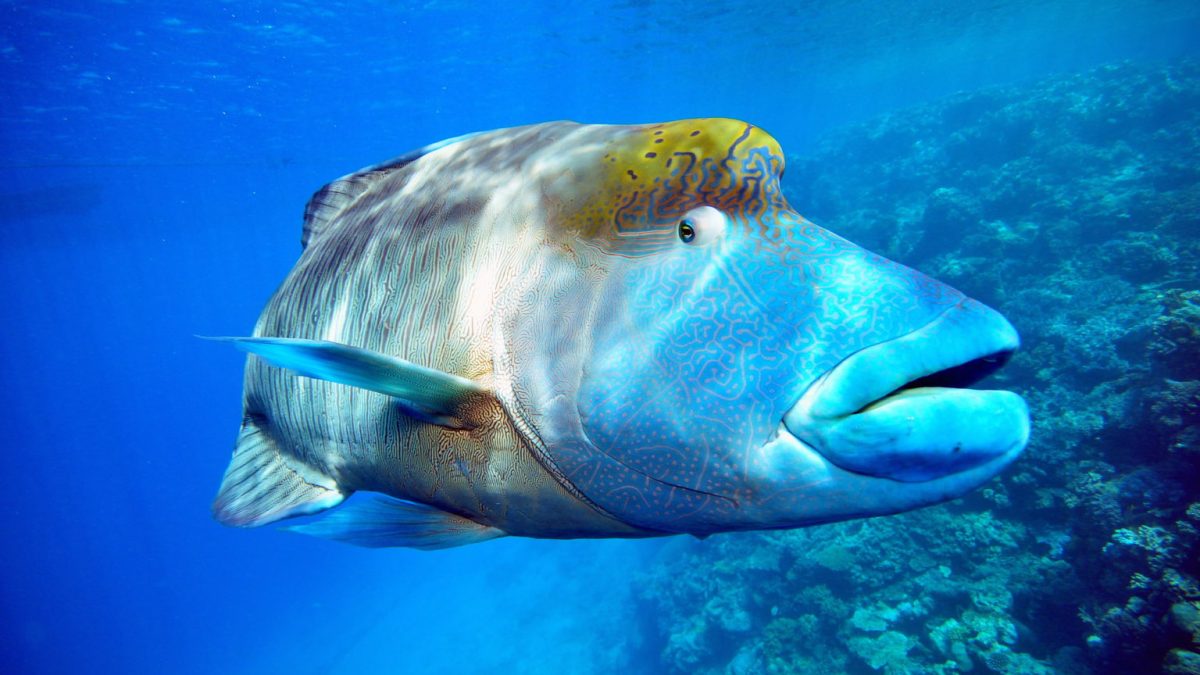
Napoleon fish in Melbourne Aquarium (Photo Credit : Larry Koester)
Napoleon fish (Cheilinus undulatus) is one of the fish species that has many characteristics, both in terms of morphology and ecological role. This species is known for its large body size, striking body color, and its important role in coral reef ecosystems. Unfortunately, these fish spread across the Indo-Pacific region are now facing serious threats due to various factors, such as overexploitation, habitat destruction, and uncontrolled fishing.
Taxonomy and Morphology of Napoleon's Fish
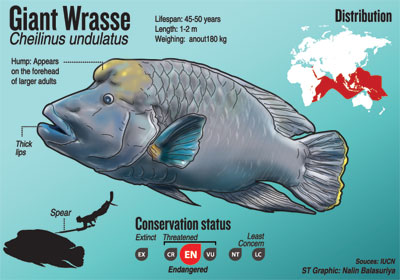
Napoleon fish morphology (Photo Credit : IUCN)
- Kingdom: Animalia
- Phylum: Chordata
- Class: Actinopterygii (true bony fish)
- Order: Perciform
- Family: Labridae (family of wrasse)
- Genus: Cheilinus
- Species: Cheilinus undulatus
The Napoleon fish is an easily recognizable species thanks to its distinctive morphological characteristics. One of its most prominent features is its large size. These fish can grow to a length of 230 cm (2.3 meters), although their average length ranges from 100 cm to 120 cm in adult individuals. The body shape is firm, elongated, and rather compact, with a large head and a prominent protrusion at the front of the head in adult males.
This large bulge is only found in males and serves as a symbol of dominance or attraction to females. The head of the Napoleon fish is relatively large and equipped with a curved mouth and sharp teeth, which allows this fish to chew hard foods, such as shellfish and other marine invertebrates. On its body, the Napoleon fish has a bright color, with a bluish-green or greenish-blue back, while the belly is lighter. Young fish have a more pronounced pattern of vertical stripes on their bodies, while in adult fish, especially males, the body color is more intense and decorated with yellow or brown stripes.
The dorsal fin of the Napoleon fish is elongated and curved, while the anal fin is comparatively smaller. The fish's tail fin is also elongated, giving it an aerodynamic feel that supports its movement in the coral-rich waters. The skin of these fish is coated with fine scales that give them a smooth surface, so they can move quickly in the water.
Reproduction of Napoleon's Fish
Napoleon fish has an interesting reproductive strategy, which involves mass spawning and external fertilization. Spawning usually occurs when the water temperature rises, and these fish will congregate in protected coral reef areas to spawn. Mass spawning is a common behavior in this species, where many male and female individuals congregate in an area and release their eggs and sperm into the water for the external fertilization process.
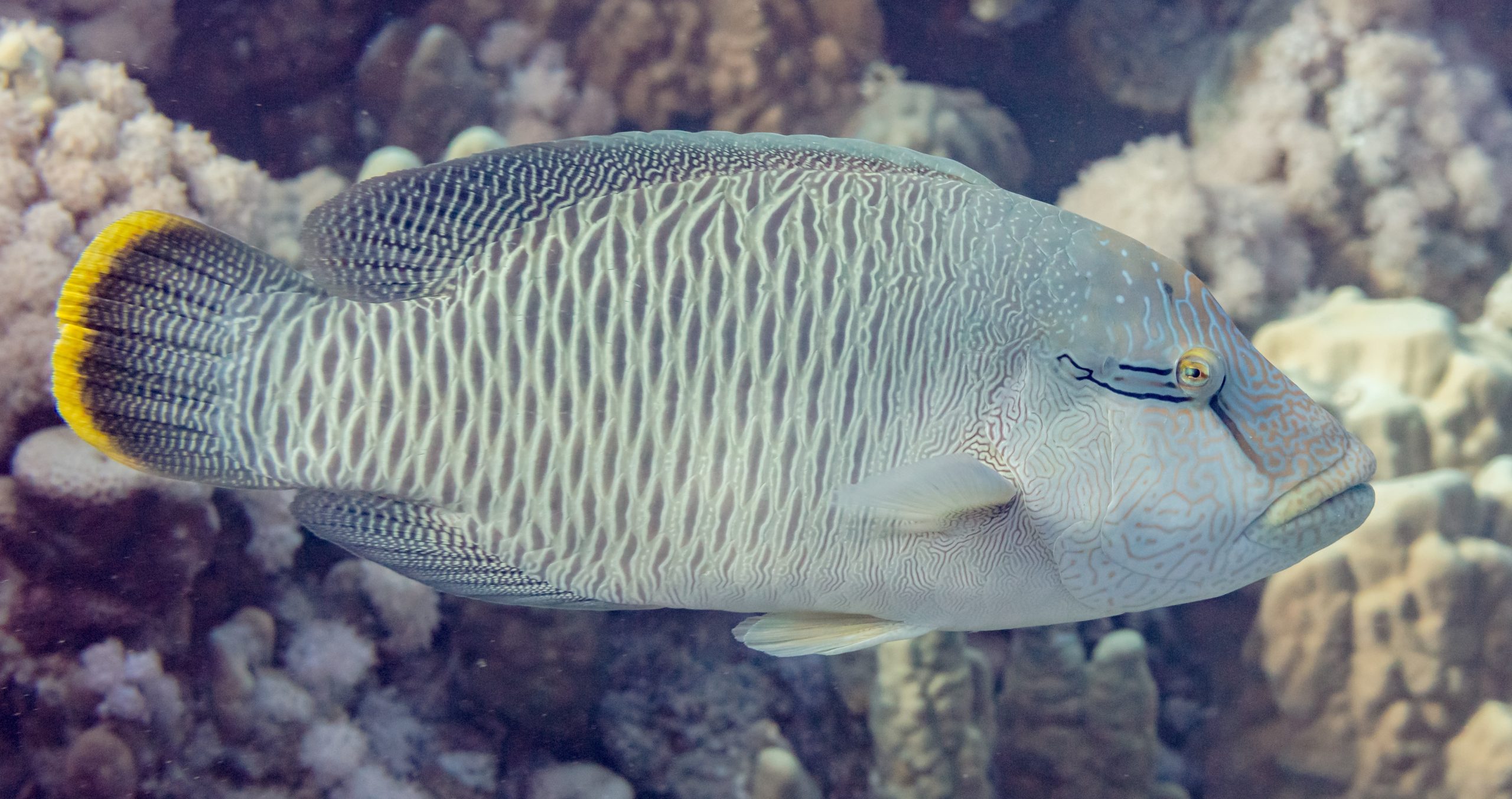
Female napoleon fish (Photo Credit : Diego Delso)
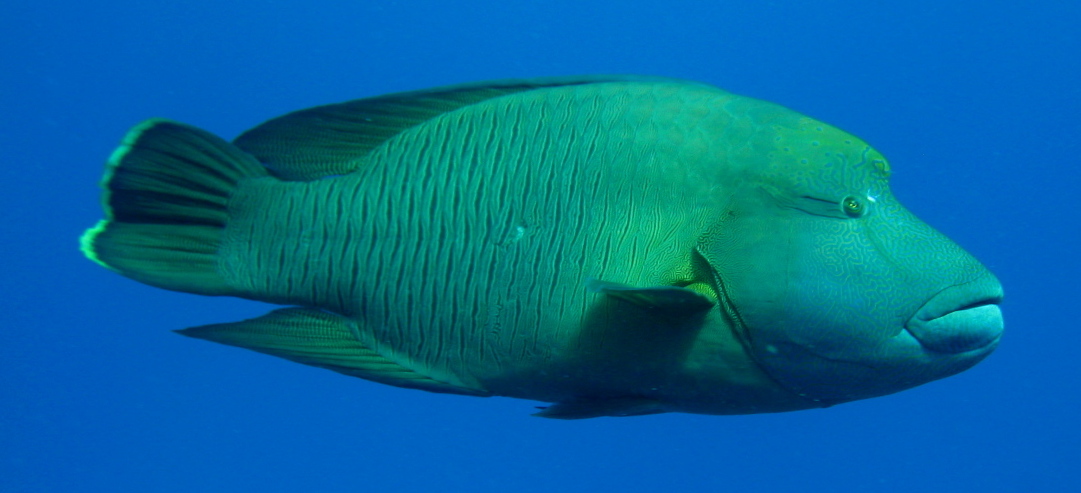
Male napoleon fish (Photo Credit : Jene0001)
The fertilized eggs float in open water and develop into larvae that will float in the open ocean for several weeks. During this larval phase, Napoleon fish rely heavily on plankton as their food source. Once hatched, the larvae will develop into young or juvenile fish that then seek shelter in shallow coral reef areas or lagoons, offering protection from predators as well as a wealth of food resources.
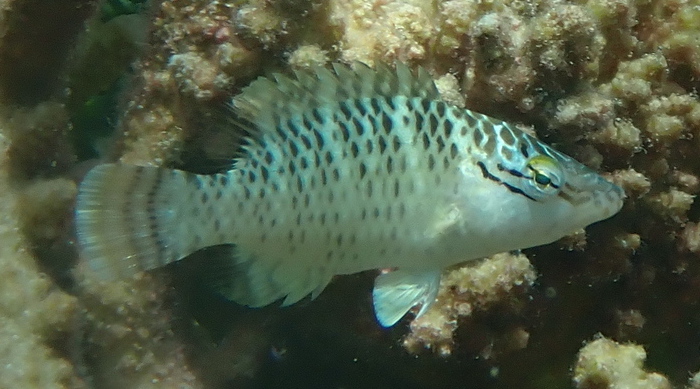
Juvenile napoleon fish (Photo Credit : Debra Baker)
One of the interesting features of Napoleon's fish reproduction is the sex change in some individuals. Females that are already large and mature can turn into males, which allows this species to adapt to the limited number of males in the group. These changes are more common in fish that have reached large and older sizes, and can be part of a survival strategy in the wild.
Habitat of Napoleon's Fish (Cheilinus undulatus)
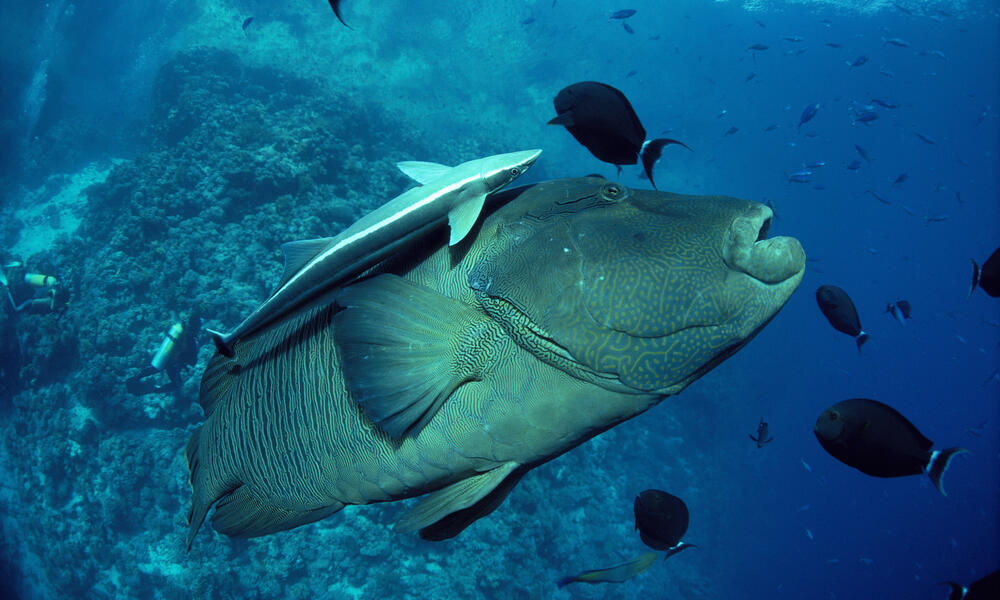
Napoleon fish with remora in the red sea (Photo Credit : Jeff Rotman/WWF)
This species is found in tropical and subtropical waters, particularly in the Indo-Pacific region. Its natural habitat is highly dependent on healthy and diverse coral reef conditions, which provide a place to breed, forage and shelter from predators. Here is some information about the habitat of Napoleon fish:
- Coral Reefs and Lagoons
Napoleon's fish are often found in sheltered coral reefs and shallow waters with depths of about 5 to 50 meters. These coral reefs provide various types of food, such as marine invertebrates (shellfish, starfish, and shrimp) which are the main source of Napoleon's fish feed. Additionally, coral reef waters offer a safe haven from large predators, especially during their growing season.
The lagoon, which is a shallow lagoon area protected by coral reefs, is also a prime habitat for young Napoleonic fish. In the larval and juvenile phases, Napoleon fish often migrate to these areas for protection and more abundant food. The lagoon's habitat also has high biodiversity, which supports the survival of Napoleon's fish.
- Ideal Environmental Conditions
It tends to like waters that have a temperature of around 26 to 30 degrees Celsius with a stable salinity level. These fish are also sensitive to changes in water quality, so their existence is highly dependent on the health of unpolluted coral reef ecosystems. Poor water quality, pollution, and damage to coral reefs caused by human activities such as coral mining and the use of destructive fishing gear seriously harm the habitat of these fish.
- Islands and Endemic Areas
It is often found in areas with large coral reef areas, such as in the waters of Indonesia, the Philippines, Papua New Guinea, as well as parts of Australia, Thailand, and Madagascar. Some of the locations in Indonesia that are the main habitat for this fish are the Banda Islands, the Raja Ampat Islands, and the Anambas Islands, which have a rich and well-maintained marine ecosystem.
- Population Density in Certain Habitats
Napoleon fish belong to a territorial species and often live in the same area during their lives. They form separate populations in different areas of coral reefs, which support the reproduction and survival of species. However, their habitats are particularly vulnerable to damage from global warming and human activities, leading to a decline in the quality of coral reefs which in turn affects Napoleon's fish populations.
- Displacement Between Habitats<
Napoleon fish are also known to move between habitats during their lives. Young fish usually begin their lives in shallow, more sheltered coral reef areas, but as they grow larger, they often move to deeper, more open waters. Adult male fish tend to be seen more often in deeper waters, while females and young fish are more often found in shallower, sheltered parts of coral reefs.
Threats to Napoleon's Fish
Although the Napoleon fish has unique morphological characteristics and is important in coral reef ecosystems, the species faces significant threats from human activities. Overexploitation, especially for the aquarium trade and human consumption, is one of the main causes of the decline in the population of this fish. Uncontrolled fishing threatens wild populations, while habitat damage, especially coral reefs, also adversely affects the survival of Napoleon's fish.
Coral reefs as a home for these fish are increasingly threatened due to global warming, pollution, and environmentally damaging fishing practices. In addition, Napoleon's fish is also threatened by illegal poaching which further increases the pressure on this species. The damage done to coral reefs directly affects the ability of these fish to lay eggs and reproduce, which further worsens the situation.
Napoleon's Fish Conservation Efforts
Napoleon's fish conservation efforts require an integrated approach between sustainable fisheries management, genetic monitoring technology, and protection of natural habitats. In Indonesia, Napoleon fish is listed in CITES Appendix II, which regulates its trade and capture to prevent extinction. One promising approach is Capture-Based Aquaculture (CBA), which is the rearing of fish farmed in captivity after being caught, to reduce pressure on wild populations.
In addition, Marine Protected Areas (MPAs) applied in coral reef areas are important for protecting the habitat of Napoleon fish and other species. In areas such as the Banda Islands, the management of protected marine areas aims to prevent illegal fishing and preserve coral reefs.
New technologies such as environmental DNA (eDNA) also play an important role in monitoring this species. With eDNA, researchers can detect the presence of Napoleon fish in the waters without having to capture them directly, which provides more accurate data on the population and distribution of this species. This technology further aids in more effective and data-driven management of Napoleon fish conservation.
The involvement of local communities in conservation through Locally Managed Marine Areas (LMMAs) is also critical. The concept of LMMAs involves coastal communities in the management and protection of their marine resources, provides economic benefits through ecotourism or sustainable fisheries, and ensures that communities participate in preserving marine species such as Napoleon's fish.
Conclusion
Napoleon fish is a marine species that has a unique morphology and an important ecological role in coral reef ecosystems. Despite this, this fish is endangered due to various factors, including overexploitation and habitat destruction. Napoleon fish conservation requires a comprehensive approach, including sustainable fisheries management, protection of coral reef habitats, and the use of advanced monitoring technologies. With the involvement of local communities and stronger law enforcement, we can safeguard the survival of Napoleon's fish and ensure the sustainability of marine ecosystems that are vital to the balance of nature and human life.
-Yuni Sulaiman
References
Arieta, S. (2022). Putting an end to the tragedy of ranching in napoleon wrasse fishery in indonesia: a sociological approach. International Journal of Social Science, 1(5), 817-828. https://doi.org/10.53625/ijss.v1i5.1333
Friedlander, A., Bukurrou, A., Filous, A., Karanassos, C., Koike, H., Koshiba, S., ... & Golbuu, Y. (2023). Assessing and managing charismatic marine megafauna in palau: bumphead parrotfish (bolbometopon muricatum) and napoleon wrasse (Cheilinus undulatus). Aquatic Conservation Marine and Freshwater Ecosystems, 33(4), 349-365. https://doi.org/10.1002/aqc.3929
Lennox, R., Filous, A., Cooke, S., & Danylchuk, A. (2019). Substantial impacts of subsistence fishing on the population status of an endangered reef predator at a remote coral atoll. Endangered Species Research, 38, 135-145. https://doi.org/10.3354/esr00942
Oktaviani, D., Suharti, S., Edrus, I., Hermana, I., Pelupessy, J., & Nugroho, D. (2021). Initiating napoleon wrasse (Cheilinus undulatus ruppell, 1835) as a species object in banda islands marine ecotourism. Iop Conference Series Earth and Environmental Science, 800(1), 012053. https://doi.org/10.1088/1755-1315/800/1/012053
Syam, A., Satria, F., Tjahjo, D., & Putri, M. (2019). Management of napoleon fish resources (Cheilinus undulatus) in the waters of the Anambas Islands. Journal of Indonesian Fisheries Policy, 11(2), 75. https://doi.org/10.15578/jkpi.11.2.2019.75-87
Telaumbanua, B., Laoli, D., Zebua, R., Zebua, O., Dawolo, J., & Zega, A. (2024). Implementation of genetic technologies for the conservation of endangered marine species: a literature review of methods and successes. Manfish, 2(2), 58-68. https://doi.org/10.62951/manfish.v2i2.46
Yan, K., Colin, P., Mitcheson, Y., & Dawson, M. (2019). Phylogeography and conservation biogeography of the humphead wrasse, Cheilinus undulatus. Frontiers of Biogeography, 11(2). https://doi.org/10.21425/f5fbg42697
Yan, K., Colin, P., Mitcheson, Y., & Dawson, M. (2019). Phylogeography and conservation biogeography of the humphead wrasse, Cheilinus undulatus. Frontiers of Biogeography, 11(2). https://doi.org/10.21425/f5fbg42697

